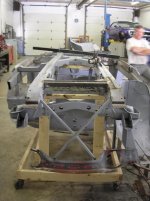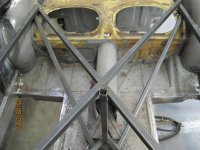The only dimensional info I found was the chassis drawing in the Bentley manual. I didn't have the luxury of having someone else do the work for me so I first built a rotisserie - I blended ideas from some plans I found on the internet. I think the rotisserie was the most helpful piece of equipment I had. I agree with pictures, pictures, pictures and, even more important, back-up the files.... I had a computer hard drive die a couple of years ago and lost almost all of my detailed disassembly photos, including component disassembly,repair and reassembly photos and I am still sick about that. So pictures & back-up and lots of notes of any measurements you can - one of the difficulties with measurements is that almost nothing is square or straight so finding a proper reference point to measure from can be really tough.
It also think it's very important to jig/brace things so you don't loose overall shape of the car when cutting out old metal. In my case I had hit a deer so I needed to straighten the frame as well as replace the rotted sills, floors and the right shut pillar completely and several places I had to replace sections of outriggers. In order to replace the sills, you have to cut off the bottom of the hinge pillars and replace them.
So, bracing things is important but IMO having access to the areas you will be working on is even more important - this also means the ability to install doors, fenders, shrouds to check fit as you go (lots and lots of times

)....not as easy as it sounds. Below are some pictures of the jig I came up with. It kept the frame straight with no sag and prevented twist in the frame and worked pretty well at giving access to things and is strictly bolt/clamp in with no welding on the car. You will need to decide what you will be replacing and what access you need so this jig may not work for you - hopefully you only need to replace some rusted sections but the car is already straight?
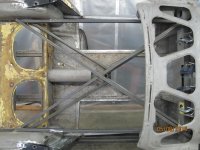
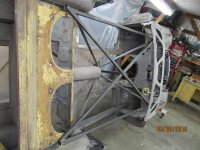
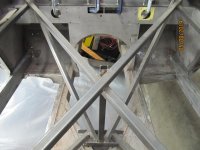
It consists of 1" square tubing and some 1/4" flat bar and a small piece of 4" channel. It's a bit hard to see in these pictures.
In the front I laid a piece of flat bar across the top of the heater cross tube and clamped thru the various openings.
In the rear I bolted pieces of flat bar to the bump-stop holes in the inner fender arches.
In the bottom I bolted a piece of 4" channel to the transmission mounting holes.
Then I shimmed as needed to get the frame straight with no sag and no twist.
Then laid the pieces of square tubing in and tacked - checking the frame for straight/true as I went and when all the pices were in place it was very rigid with no deflection as it turned on the rotisserie.
Before cutting anything apart, I loaded about 15 50# bags of pellet stove pellets in the passenger area and checked for any deflection - and this is on the rotisserie which has more of a tendency to produce flex than loading on the suspension points would.
So I did all frame/chassis repair and pre-hung doors & fenders and rebuilt the damaged shrouds and installed body patch panels and made sure they fit with decent gaps, all on the rotisserie.
I removed the brace to blast and prime/paint the chassis and will do all final hanging/fitting of body parts without it.
When I removed it there was about a 1/16 movement in the chassis between the front where the braces clamped to the heater tube and the rear where it bolted to the rear inner fender arches.
Anyway, this system worked well for me and if you have any questions, I have a few more pictures.
Dave

 Hi Guest!
Hi Guest!

 smilie in place of the real @
smilie in place of the real @
 Pretty Please - add it to our Events forum(s) and add to the calendar! >>
Pretty Please - add it to our Events forum(s) and add to the calendar! >> 

